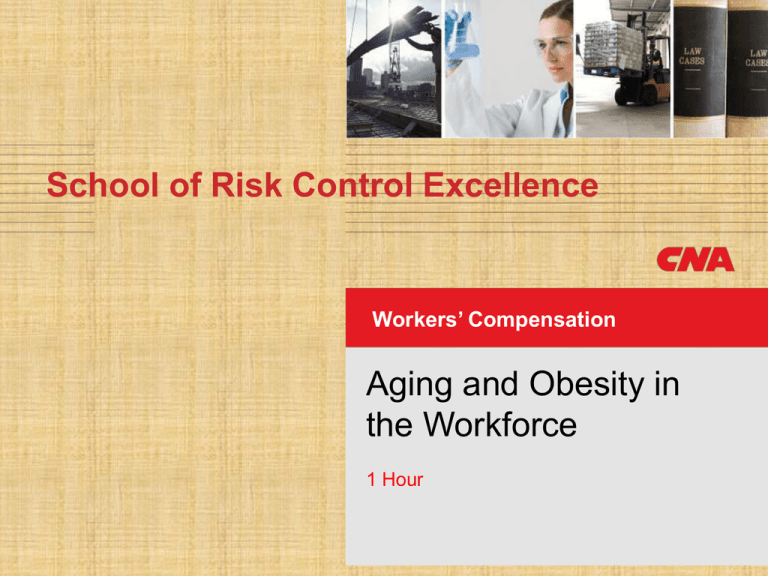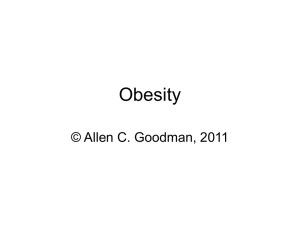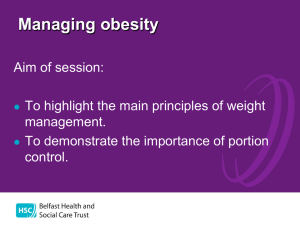
School of Risk Control Excellence
Workers’ Compensation
Aging and Obesity in
the Workforce
1 Hour
Disclaimer
The information, examples and suggestions presented in this material
have been developed from sources believed to be reliable, but they
should not be construed as legal or other professional advice. CNA
accepts no responsibility for the accuracy or completeness of this
material and recommends the consultation with competent legal counsel
and/or other professional advisors before applying this material in any
particular factual situations. This material is for illustrative purposes and
is not intended to constitute a contract. Please remember that only the
relevant insurance policy can provide the actual terms, coverages,
amounts, conditions and exclusions for an insured. All products and
services may not be available in all states and may be subject to
change without notice. References to the services of external third
parties are provided solely for convenience and CNA disclaims any
responsibility with respect thereto. CNA is a registered trademark of
CNA Financial Corporation. Copyright © 2011 CNA. All rights reserved.
2
Learning Objectives
At the end of this course you should be able to:
■ Describe the physical limitations affecting the aging
workforce
■ Discuss the workforce demographics found in a plant
that can affect injuries
■ Indentify factors that impact injuries in relation to
obesity
3
What is the number one issue that will affect all
industries in the United states besides the
economy?
It will affect all industries and they will all be fighting over the
same employees.
4
CURRENT POPULATION
More than 40% of Construction workers are Baby Boomers.
By 2015 – 55 million workers 45 or older. Nearly half of all workers
will be considered aging.
14 to 15 million people will be 65-69 in 2015.
Those between ages 24 and 54 will only increase 5%.
These demographics predict an exodus of experienced workers
from this industry.
5
Percent Growth in U.S. Workforce by Age: 2000-2020
80%
73%
54%
60%
40%
20%
7%
8%
7%
3%
0%
-10%
-20%
under 14
15-24
25-34
35-44
45-55
55-64
65+
Age of Workers
6
Source: U.S. Census Bureau
Current Worker Population
The point is:
• Those in the age range of 24 to 34 are not
increasing.
• Those 35-45 are projected to decrease.
• Those over 55 will be increasing.
• How are you going to keep your operations on
cost and on quality?
7
Aging Workers: Creating the Environment for a Healthy Workforce: A Medical and Biomechanical Approach – R. Wayne
Baby Boomers
■ Has your organization recognized the need to leverage
the aging workforce to produce on the job site or in the
plant?
■ What about your competitors?
■ These fundamental questions must be reviewed!
8
Physical Limitations
■ Physical capabilities decline with age (around 50).
■ These relate to the following tasks:
• Strength
• Range of motion
• Speed of movement
• Fatigue
• Motor skills
• Balance
Ergonomics, How to Design for Ease & Efficiency, Karl Kroemer, Henrike Kroemer, Katrin Kroemer-Elbert
9
AS WE AGE
Maximal Strength
Muscle Mass
Bone density
Visual and Auditory
Acuity
Fitness
Aerobic Capacity
Cognitive
Speed/Function
10
Obesity
Arthritis
High BP
Diabetes
Depression/Heart
Disease
Menopausal/Post
Menopausal Issues
Physical Limitations (continued)
■ Driving and operating large equipment requires
responding continuously to spatial and temporal (time)
information from the environment and equipment.
■ Motor control is critical for coordinating movements of
the head, neck, and upper and lower limbs.
■ Motor control is also critical when:
■ using powered and non-powered tools, going up and
down ladders, manually handling materials and
braking, steering, and turning. Also ability to work
overhead, reaching, bending and kneeling.
■ Reduce motor control can effect quality if critical
measures are needed.
11
Physical Limitations (continued)
■ Strength decreases in older workers.
■ In construction job site settings, workers still have to lift,
lower, push, pull, and carry material.
■ Many of the designs and work task setups do not take
this decrease in strength into consideration. Thus, the
older worker may not have the maximum strength to
apply.
■ We have to look at the design to take advantage of:
■ Leverage
■ Handle designs
■ Mechanical advantages
12
Balance
■ The sense of balance is affected by age.
■ We can lose as much as 40% vestibular hair and inner
ear nerve cells.
■ Combining vision and strength shifts, maintaining
balance becomes a much more difficult endeavor.
Examples: Ladders, scaffold, other elevated work, roof
edges, etc.
■ Rethink how we are using these and who will be
allowed to use them
13
Aging Trends – Average Loss Work Days
50
45
40
35
30
25
20
15
10
5 1.67
0
0 to 18
14
48.9
47.7
Average
Days Lost
37.8
31.3
18.09
10.4
19 to 29
30 to 39
40 to 49
50 to 59
60 to 64
65+
With this in mind… Here are the key questions
Is your workforce physically capable of doing their job
now?
Will your workforce be physically capable of doing their
job 10 years from now?
How many more bends, twists and lifts do they have
left?
What effect is this having on my company besides
safety?
15
Controls and Suggestions (continued)
Consider the following strategies:
1. Review your organizations safety and engineering
requirements. Are job limits, work method techniques, and
organizational policies accommodating to the known and
expected capability shifts of older workers?
2. Limit frequently changing job requirements. Changing
requirements negatively impacts older workers’ abilities to
leverage past experiences.
3. Allow older workers certain flexibility in approaching the
job. Let them leverage their knowledge and wisdom. Consider
how they make the job easier for themselves. (only if methods
are safe)
16
Controls and Suggestions (continued)
Consider the following strategies:
4. Leaner concepts;
- Reduce walking and climbing of ladders (fatigue)
- Ergonomic workstation adjustments
- Getting materials off the floor,
5. Improve illumination.
6. Reduce or eliminate heavy lifting and long reaches.
7. Consider reaction time when assigning older workers to
tasks.
8. Hiring using Post offer Physical Capacity Evaluations
17
Areas for Management to Review
Demographic Analysis
■
■
■
■
■
■
■
18
What is the age of the workforce?
What is the total population?
List by job type.
Are more than 10% over 50?
What type of injuries are occurring?
What will change in the next 5 to 10 years?
What is the profile of the future?
Areas for Management to Review (continued)
■
■
■
■
■
■
What are the risk factors creating the injuries?
What are the ergonomic/biomechanical Issues?
How do the risk factors impact aging?
How is the aging work force impacting productivity?
How can we begin to mitigate/reduce the risk factor?
Does transitional/return-to-work (RTW) take into
consideration aging?
■ Do long term plans include aging?
19
Definitions of Obesity
■ Obesity: Body Mass Index (BMI) of 30 or higher.
■ Body Mass Index (BMI): A measure of an adult’s weight
in relation to his or her height, specifically the adult’s
weight in kilograms divided by the square of his or her
height in meters.
■ BMI was developed in the 1940’s, but is still used by
today’s physicians.
CDC – National Center for Health Statistics;Prevalence of Overweight, Obesity and Extreme Obesity Among Adults: United States, Trends 1976-180
Through 2007-2008
20
Definitions of Obesity
■ Obese is generally defined as a BMI of 30.
■ Morbidly obese is defined as a BMI of 40.
■ Super obese is defined as a BMI of 50 or more.
Http://www.super-supplements-and-nutrition.com/super-obese.html
21
Scope of the Problem
■ The most obese workers file twice as many WC claims as
healthy weight workers.
■ The most obese have 13 times more lost workdays than healthy
weight workers.
■ Workers Compensation medical claims cost are 6.8 times higher
for the most obese workers.
■ Obesity could result in as much as 34.5% increase in healthcare
costs for obesity-related health problems*
* Source: Thomas J. Bukowski. Weighting down safety Health and Safety Magazine, April 2013 from the Trust fo America’s Health and the Robert Wood Johnson
Foundation report
22
Source: Ostbye, T. Obesity and Workers Compensation. Archives of Internal Medicine, April 23, 2007 Emerging Risks in Workers
Compensation, Workers Compensation Educational Conference, Robert Hartwig, PHD, CPCU, President Insurance Information
Institute
Scope of the Problem (continued)
■ Indemnity costs are 11 times higher for most obese workers than
healthy weight workers.
■ The body parts most prone to injury are: back, lower extremities,
wrist, and hands.
■ The most common causes of these injuries were falls, lifting, and
slipping.
Obesity Increases Workers Compensation Cost, www.medicalnewstoday.com/articles/68795.php 1/25/2010
23
Face and Eyes
Incorrect use of PPE
Throat
AS Sleep
WEApnea
AGE
■ More difficult to fit
■ Less Comfortable, less use
Increased fatigue
and alertness
Heart
Cardiac Arrest, Heart
Disease
Upper/Lower Back
■ Equipment Capacity limits- fall
protection, ladders, bucket trucks
■ Increased risk of back injury due
to added upper body weight
Upper and Lower
Arms
Lungs
Asthma: dyspnea
Shortness of breath
Decreases ability to take in
air, increasing fatigue
Constricted blood vessels
Vibration Syndromes
Waist
Wrists and Hands
Large abdomen
Restricted blood flow
May be difficult to fit into
24
machinery or PPE
Safety and Health magazine – April 2013
Thomas J. Bukowski, Associate Editor
Vibration Syndromes
Carpal Tunnel Syndrome
Percent of Obese (BMI > 30) in U.S. Adults
Centers for Disease Control & Prevention (CDC)
1990
No Data
25
<10%
10%–14%
Percent of Obese (BMI > 30) in U.S. Adults
Centers for Disease Control & Prevention (CDC)
1999
No Data
26
<10%
10%–14%
15%–19%
20%–24%
Percent of Obese (BMI > 30) in U.S. Adults
27
Percent of Obese (BMI > 30) in U.S. Adults
28
Percent of Obese (BMI > 30) in U.S. Adults
29
Obesity and Worker Compensation
■ Study released in July 2009 found California total annual estimated cost
for overweight and obesity was approximately 41.2 billion.
■ Lost productivity costs associated with overweight and obesity was 8.2
billion.
The Economic Costs of Overweight, Obesity, and Physical Inactivity Among California Adults – 2006,
www.publichealthadvocacy.org/costofobesity.html
30
CNA Claim Findings
■ CNA completed a survey of our workers’ compensation (WC) files.
■ WC adjusters were randomly selected with 10% of the adjusters
and 8% of open or reopened files represented.
■ Findings:
• 85% of respondents indicated that they have dealt with
overweight/obesity issues on their claim files in the last six
months.
• 7% of claim files in the survey have overweight/obesity issues.
• When asked to determine the effects of obesity (no effect,
limited effect, some effect, or considerable effect), 58%
indicated a considerable effect.
31
CNA Claim Findings (continued)
■ Top two diagnoses on affected claim files were backs
(47%) and knees (31%).
■ Male/female split for affected files was 50%-50%.
32
What Employers Can Do
■ Many companies have avoided identifying individuals who
are obese because there is a perceived stigma of being
discriminatory.
■ One of the solutions is to contact TrestleTree®
a
company specializing on how to address the problem of
obesity or offer voluntary programs and incentives for
those who are motivated to take part.
33
What Employers Can Do (continued)
■ Things to do:
• Make on-site programs, like Weight Watchers®, available at
work.
• Sponsor or subsidize health club memberships.
• Work with group health vendors to develop more programs to
target obese populations.
• Implement a healthy eating campaign which should include
healthy options in cafeterias and vending machines.
• Replace candy bowls with fruit bowls at the front desk
34
What Employers Can Do (continued)
■ Things to do:
• Encourage employees to walk during their lunch.
• Incorporate walking meetings when possible.
• Provide employee assistance programs for private counseling
or community-based weight management programs.
• Offer incentives, such as discount on health care premiums.
• Encourage the drinking of water instead of sugary drinks
• Incorporate stretch breaks into meetings
35
Learning Objectives
Review:
■ Describe the physical limitations affecting the aging
workforce.
■ Discuss the workforce demographics found in a plant
that can affect injuries.
■ Indentify factors that impact injuries in relation to
obesity.
36
Questions?
37
38








